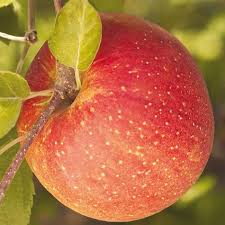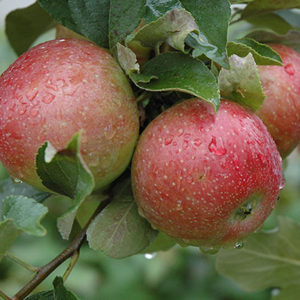Cortland
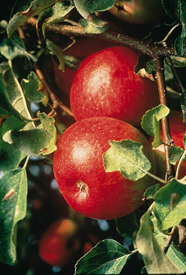
Cortland is a cross of McIntosh x Ben Davis first produced in Geneva, New York 1915.
Dark red flush against a yellow-green background, with very white crisp flesh. One of the best salad apples because it doesn’t brown quickly. Appley, sweet, and juicy. Apple is ready to harvest in September, does not keep well, so eat by early October.
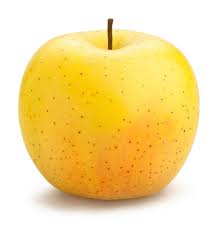 Golden Delicious
Golden Delicious
Golden Delicious apples are pale green to golden yellow in color and speckled with small lenticels (spots). They are small to medium in size, and tend to be conical or oblong in shape. Golden Delicious apples are firm, crisp, and white-fleshed. These apples have a balanced sweet-tart aromatic flavor, which has been described as honeyed. The sweet-tartness of the Golden Delicious means this apple is a good fresh eating variety.
GoldRush
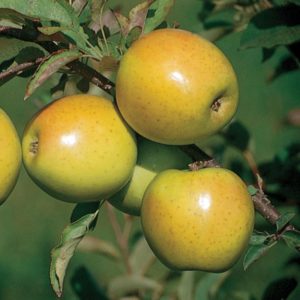
Also known as: Co-Op 38. Co-Op 17 x Golden Delicious. Developed by PRI (Purdue, Rutgers, Illinois Co Op) in 1994.
The apple is conic-round, medium large, and a deep uniform greenish yellow. Flesh is hard, very crisp and breaking, flavor intense and memorable. Both sugar and acid levels are high (soluble solids seldom below 17%), the balance slightly favoring tartness at harvest, then mellowing in storage. The complex flavor profile makes it extremely valuable in cider production. Length of storage almost without parallel, in excess of six months, good texture out of a household refrigerator as late as July or August.
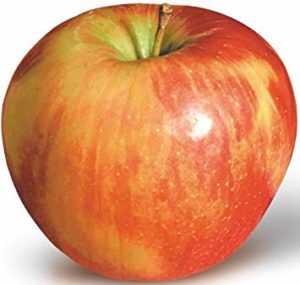
Honeycrisp
Honeycrisp is an open pollinated seedling of Keepsake released by the University of Minnesota, 1991.
Color is red mottled over a yellow background. Has excellent eating and keeping qualities. Everyone loves Honeycrisp, it is sweet, dilute, very crisp, and juicy. Ready to harvest mid-September to early October, will keep with excellent flavor till January.
King David
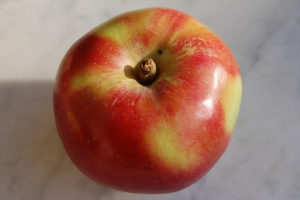
King David was found on a fencerow in Arkansas in 1893. This antique is speculated to be a cross of Jonathan and Winesap. King David is winey, rich, slightly spicy, and flavorful. Fruits never seem to drop and increase in brilliance of color as the season goes on. For best eating, should be picked when the red color becomes complete. This American apple is great for fresh eating, baking, applesauce, and cider.
Apples ripen late October to early November in Western New York; peak flavor is October-December, and store well. The fruit is medium size, pale green and overlaid with deep dark red.
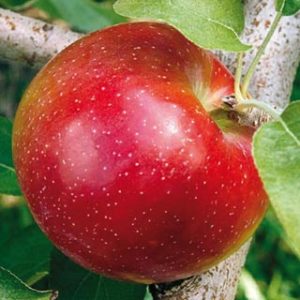 Liberty
Liberty
Liberty is a cross of Macoun x Purdue 54-12 bred at the New York Agricultural Station in Geneva, first released to the public in 1972. This variety is extremely disease resistant, and perfect for home growers that do not want to spray.
The apple is large and with a red blush covering nearly all of yellow fruit, sweet, crisp and juicy. It is perfect for fresh-eating or for a sweet cider apple. Liberty is the backbone of any organic orchard. Ready to harvest around September 20 in Western New York. Flavor develops over one month of storage.
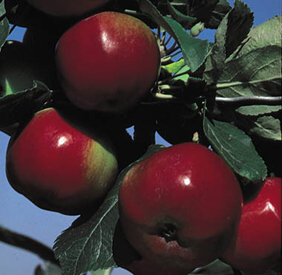 McIntosh
McIntosh
McIntosh, or Mac, is an apple cultivar that was discovered by John McIntosh on his Dundela farm in Canada in 1811. McIntosh apples are vivid red brushed with bright green, oftentimes speckled with white lenticels (spots). The amount of red or green on the skin of the McIntosh will vary depending on when it was harvested. Early season apples will have more green and later season will sometimes be almost all red. The flavor as well will vary, with the later season apples taking on a slightly sweeter taste than those picked earlier in the season. The McIntosh apples crisp flesh is exceptionally juicy and bright white in color. When first picked the flavor of the McIntosh apple has a strong sweet-tart taste with nuances of spice, this flavor will mellow slightly in cold storage. Ripens in August.
Northern Spy
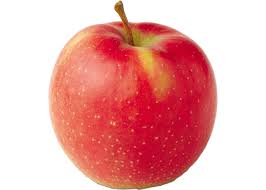
Northern Spy is an heirloom apple first discovered in upstate New York around 1800 used for baking, fresh eating and cider. Parentage is unknown, and it was likely a chance seedling.
Large, round, often flattened greenish-yellow fruit flushed and striped pinkish red with a delicate bloom, and occasionally russet patches. Fine grained, rather firm, very tender, crisp, juicy, yellowish flesh. Tart, aromatic, and acidic flavor balanced with syrupy sweetness. Excellent all-purpose apple, except not good for drying. Ferments into a crisp, clean cider.
Fruit ripens late October.
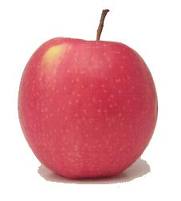 Pink Lady
Pink Lady
Pink Lady, or Cripps Pink is a modern cross of Golden Delicious x Lady Williams produced in southwestern Australia in the 1990s.
Oblong, green fruit turns yellow at maturity and is overlaid with a pink or light red blush. Fine-grained, white flesh that doesn’t brown after being cut. Flavor is sweet, tropical, and sweet-tart. Thin skin bruises easily. Fruit will store for six to eight months in common storage. Ripens late September – early October.
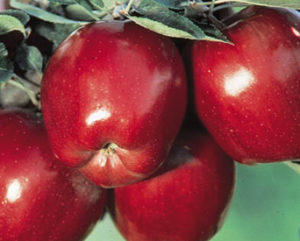 Red Delicious
Red Delicious
The Red Delicious apple variety was discovered in 1875 as a chance seedling growing on Jesse Hiatt’s farm in Peru, Iowa. It is one of the most famous American apples, and one of the most widely grown apple varieties. Although the names are similar, Red Delicious and Golden Delicious are entirely different varieties. Red Delicious is a medium-sized apple, with a tall conical shape. The dark and intense crimson colour makes it the quintessential red apple, and it is has strong shelf appeal. Red Delicious has a sweet but very mild flavor, somewhat reminscent of slightly over-ripe melon. The flesh is juicy and has a light crispness.
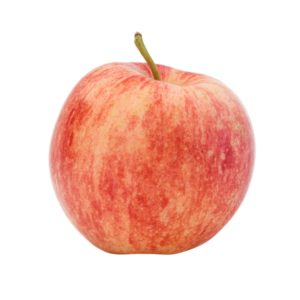 Sansa
Sansa
Sansa is a Japanese fresh eating apple first released in 1988, a cross of Akane x Gala. In 1969, Japanese researcher Dr. Yoshio Yoshida sent pollen from the Akane variety to his colleague in New Zealand, Dr. Don McKenzie, and asked him to use it to cross-pollinate Gala blossoms. The seeds that resulted from the cross were returned to Japan where researchers evaluated the trees and fruit for nearly 20 years.
The Sansa is a spectacularily good apple, sweet with more complexity than Akane. It has a bright red striped blush over a pale, yellow-green background. The fruit is firm, yet tender, juicy and exceptionally sweet.As with many early apples, Sansa should be enjoyed fresh, soon after harvest, for a terrific eating experience.
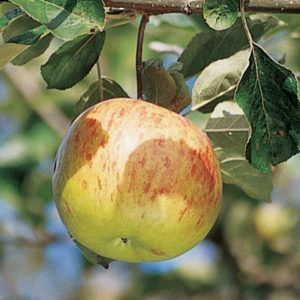 Spigold
Spigold
Spigold is a cross between Golden Delicious x Red Spy first developed at the Geneva Agriculutral Experiment Station in New York, 1962.
Very large (some up to 1 lb) golden yellow fruit, 75% covered with bright red stripes. Tender skin. Fine grained, firm, crisp, yellow flesh, sprightly, aromatic, and sweet. Stores well. Flavor may improve in storage. Ripens early to mid-October, will keep till January.
Sweet Sixteen
Parentage/Origin: Northern Spy x MN 447; Minnesota, 1973. Harvest: September-October. Stores well. Rosy red, crisp, juicy and sweet. Perfect fresh or baked into pies, crisps and cobblers. Fans say it has a hint of vanilla flavor. Apples are medium-to-large and store well.
Winecrisp (Co-op 31)
Winecrisp, also known as Co-op 31, is a disease resistant apple released by PRI in 1990. Parentage includes Cox Orange Pippin, Newtown Pippin, Jonathan & Red Rome.
The fruit is medium to coarse grained, cream colored, firm, very crisp and breaking flesh; relatively thin, palatable skin; mildly sub-acid; spicy, full, rich flavor; juicy. Very good quality. Retains flesh texture and quality for six months or more in refrigerated storage. Winter storage apple with flavor that peaks after one month in refrigerated storage. Ripens mid October, two weeks after Delicious.
Zestar
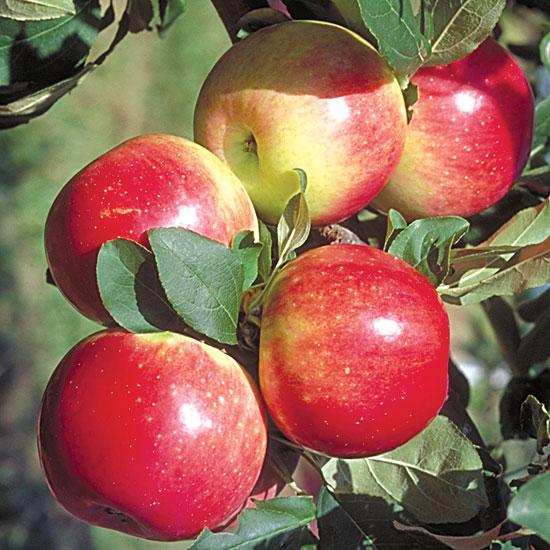
University of Minnesota. Large, crunchy, juicy red fruit with a sprightly sweet-tart flavor. Excellent for both fresh eating and cooking. The fruit will store for 6 to 8 weeks. Ripens late August to early September.
